Last updated: May 20, 2021
Article
Caribbean Trade and Networks
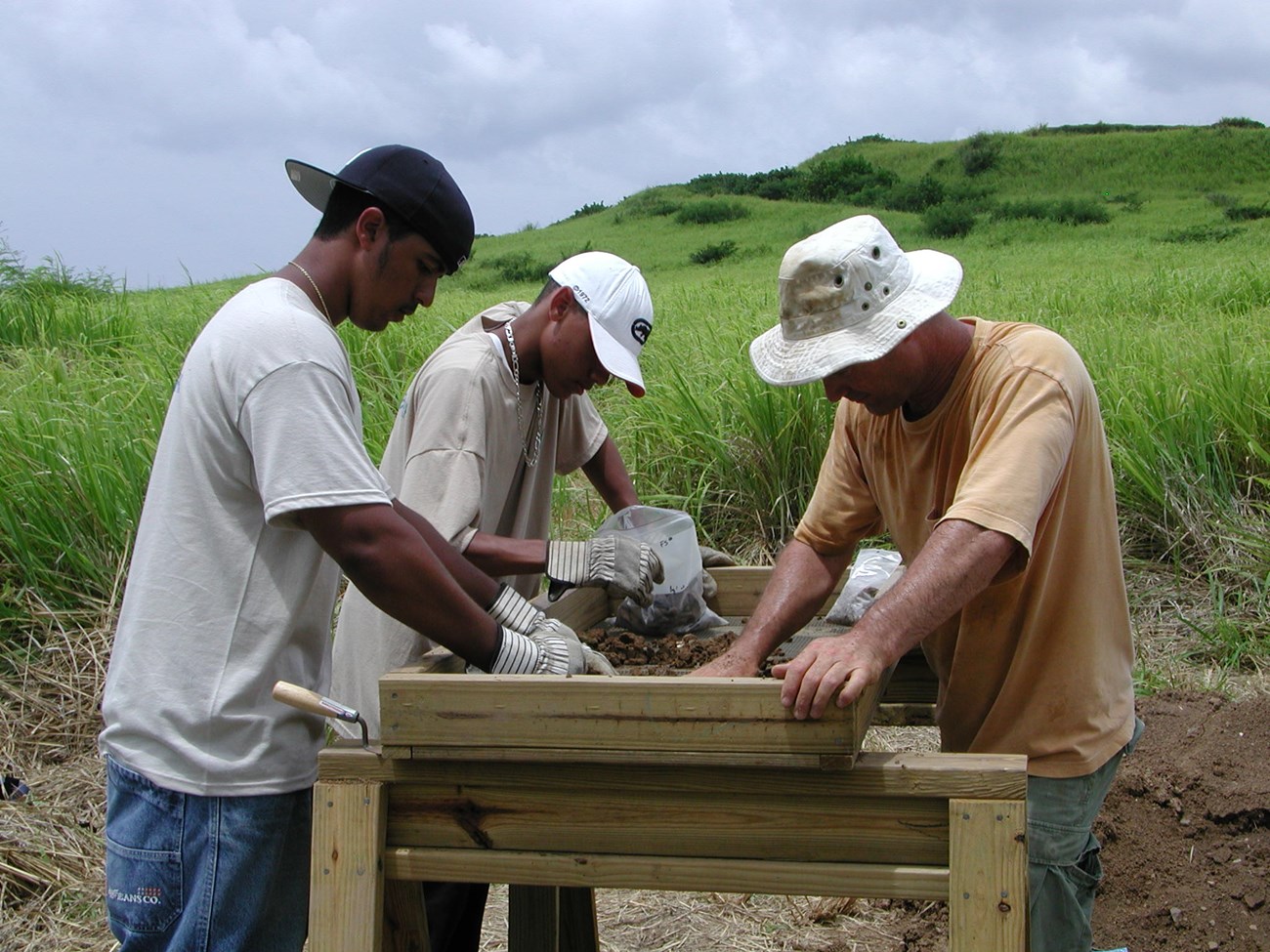
(NPS Photo)

(NPS Photo)
Dr. Meredith D. Hardy (Southeast Archeological Center) conducted a two-part study on prehistoric Caribbean artifacts from both the Folmer Andersen Collection, housed at Christiansted National Historic Site (CHRI), St. Croix, U.S. Virgin Islands, and artifacts excavated from Salt River Bay National Historic Site and Ecological Preserve (SARI) (Figure 1).
The study focused on the kinds of social and political organizations and the economy of Saladoid-era (ca. 400 B.C. to A.D. 600) peoples on St. Croix. It used archeological and settlement pattern data as a case study to better understand the lives of ancient Caribbean societies, how they settled the landscape, their interactions, contacts, and exchanges both among themselves and their island neighbors, and how these communities, societies, and their interactions changed over time.
Dr. Hardy's research has demonstrated that the ancient societies on St. Croix were much more complex than previously believed, and participated in long-distance interaction and trade networks that spanned across the Caribbean. Both parts of this study involved a geochemical composition analysis, of two kinds of artifacts, 1) Saladoid period pottery dating from ca. 400 B.C. to A.D. 600, and local clays likely used to make them, and 2) finely carved and ground stone ornaments, celts, and axes made from semi-precious stones not available on St. Croix nor neighboring islands. These kinds of artifacts were most likely produced by craft specialists within the local island societies, and are often cited as evidence for communication and contacts between different communities both on and between islands.
There have been few attempts to assemble detailed physiographic, geological, and archeological data in order to locate potential sources of clays used to make pottery, and stone objects used to make tools and ornaments, for the ancient societies of the Caribbean.
Who were these people? The early ceramic-making farmer-fishers commonly referred to as Saladoid have been most often described as egalitarian tribes. These peoples, originally living along the middle Orinoco River of lowland Amazonia, made fine, high-fired decorated pottery and planted gardens where they grew manioc and many kinds of fruits. There were numerous societies and communities throughout the northeastern South America and Lowland Amazonia, and that their travels, exchanges, and interactions were not sporadic. Possibly because of competition for limited farmable land and increasing populations, beginning sometime around ca. 1000 − 500 B.C., groups of Early Ceramic Saladoid peoples traveled down the Orinoco, crossed the Gulf of Paria, and spread both east and west along the Venezuelan and Guayanan coasts, continuing up to the islands of the northern Lesser Antilles and the Vieques Sound. They finally reached the larger, environmentally diverse and sedimentary islands of the Virgin Islands, Puerto Rico, and eastern Hispaniola (Dominican Republic). It was here that the Arawakan Saladoid peoples halted their travels. The social organization of Saladoid communities has generally been interpreted as egalitarian, based largely on an apparent absence of hierarchical patterns of settlement, burial, and artifact distributions However, there are many forms of social rank and temporary hierarchies found in many tribal societies.
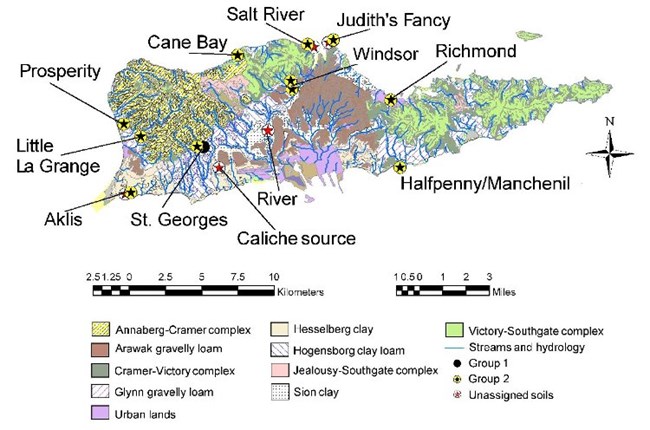
(NPS Photo)
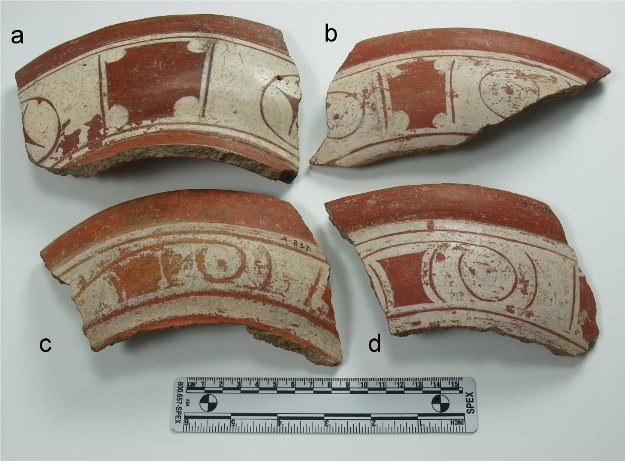
(NPS Photo)
Archeologists recognize two major decorative ceramic series within Saladoid culture - Huecan and Cedrosan − in addition to daily use or utilitarian wares. Huecan subseries pottery typically consists of zone-incised and crosshatched (ZIC) (Figure 2) designs normally restricted to vessel rims and flanges, while Cedrosan pottery has fine white-on-red painting (WOR wares) (Figure 3). Both WOR and ZIC wares require skill in ceramic technology, the ability to make films and paints, and skill in the execution of designs. Because of the skill levels required for their production, it does not seem likely that these were daily use wares, but were made by at least part-time specialists for particular reasons, whether ritual, feasting events, or individual status symbols.
They made grinding, pecking, chopping, and cutting tools out of stone, shell, coral, bone, and wood, into forms such as awls, knives, flake tools, bone points and harpoons, hooks, metates, grinding stones, adzes, celts, and hammerstones. Other artifacts associated with Saladoid culture and daily life activities include carved shell masks, pendants made of shell and turtle bone, stone net sinkers, and ceramic spindle whorls used to spin fibers into thread. They weaved baskets out of grasses and leaves, and made cloth, nets, and other objects from native cotton and possibly other plants.
There is evidence for extensive circum-Caribbean and interisland trade networks among the early Saladoid cultures in the form of a far-reaching lapidary industry using exotic materials.
These people participated in broad networks of interaction, communication, and exchange of information and goods that maintained and continued traditions of pottery making and decoration. These communication and trade networks also moved stone objects made from materials not available locally. Over time, there was a gradual divergence of series and styles into regionalized traditions that developed within growing local and regional interaction spheres.
By around A.D. 600, political and economic fragmentation resulted in a massive reorganization of the forms of leadership and social status that eventually developed into the hierarchical chiefdoms of the later Ostionoid period (ca. A.D. 1200-1400), commonly referred to as the Taíno. As populations increased and villages either grew or budded off, a need for further self definition of in-group status membership developed. The growing of manioc and using of clay griddles remained a mainstay of Ostionoid subsistence, but new agricultural practices were developed and adopted. During this time, villages became hierarchically ordered, but the basic settlement pattern remained the same. Some villages remained small and may have served as agricultural hamlets or activity camps while others grew to be regional centers of power.
The ancient communities of the Caribbean should not be thought of as a single, massive society, following a single ruler or even sets of rules. Instead, they should be viewed as separate villages and tribes linked together by similar belief systems, world views, and practices and activities. Even those who lived on a single large island, like Puerto Rico or Hispaniola, were divided into many different communities, where they formed alliances, waged battles, and followed different leaders.
There have been many unanswered questions surrounding both the production of pottery and the movement of finely carved stone objects, how objects with very similar styles came to arrive on the islands, and how these styles changed over time on most of these islands. It has long been assumed that these ancient societies and communities interacted with each other, sharing knowledge, advice, and even gossip. These communications would account for similar changes in style and production in many kinds of goods, such as pottery, stone, and even carved shell and bone. But did these people move objects themselves? Did they trade pottery and stones, did they take things with them and bring home other goods? These are the kinds of questions that are best addressed through controlled, scientific studies that produce undeniable answers. Chemistry studies on objects made from stone and clay (geochemistry) can produce such answers.
Chemical studies of pottery from across the Caribbean have yielded evidence that the movement of goods between islands is nearly constant, through both prehistoric and colonial times (Carini 1991; O’Connor 2001; Potter 1996). In general, these studies found, through an array of techniques, including proton induced x-ray emission (PIXE) and x-ray diffraction (XRD), emission spectrography, infrared absorption spectrophotometry, x-ray fluorescence, petrographic microscopy, and electron scanning microscopy, that while some ceramics were traded between islands, others were used in close proximity to where they were produced. There have also been few compositional studies of lithic materials recovered from these archaeological sites. Dr. Hardy’s study was an attempt to answer these questions specifically on the ancient societies of St. Croix.
Part I. Ceramic Study
The first part of the study was a preliminary analysis of prehistoric pottery sherds dating from ca. 400 B.C. to A.D. 600, and local clays that were likely used to make the pottery to determine their chemical composition, using neutron activation analysis (NAA) (Figures 4a and 4b). The purpose for this study was to identify possible locations where the clays used to make the pottery were gathered. Where a person chooses to gather their clays provides a glimpse into the possible interaction and trade networks used to move pottery from one place to another (Costin 2007; Rice 2006). Besides the natural availability of clays and tempering agents, social factors also come into play regarding procurement strategies. These include control of access to resources, political and kinship relations between the potter and those who control the resource, social boundaries, and cultural meanings and rules surrounding the making of a ceramic vessel for ritual or ceremonial use.
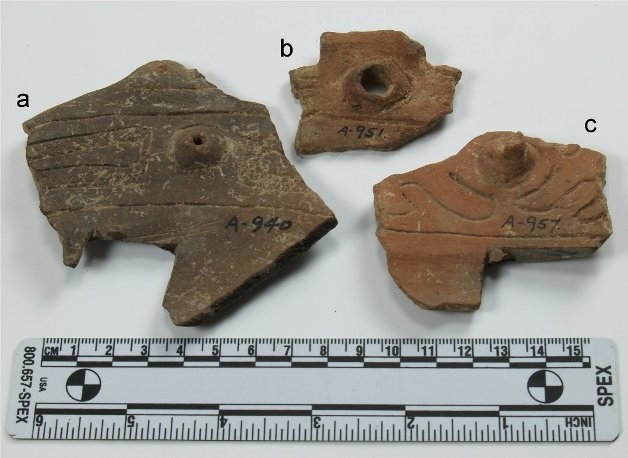
(NPS Photo)
Eighty-six samples of prehistoric pottery sherds and raw clays were submitted to the Archeometry Laboratory of the University of Missouri Research Reactor Center (MURR): 75 ceramic sherds and 11 clay samples (Ferguson and Glascock 2006). Thirty-eight of the pottery sherds were a part of the Folmer Andersen Collection of Prehistoric Artifacts, kept and managed by the National Park Service — Christiansted National Historic Site. Folmer Andersen was an avid part-time and non-professional archeologist who lived and worked on St. Croix in the early 1900s. The Folmer Andersen Collection, consisting of about 13,000 artifacts from archeological sites located across the island, is one of the largest collections of prehistoric Caribbean materials gathered. Pottery sherds that were selected represented a variety of styles and manufacturing quality, ranging from thin, highly fired wares to thicker, coarse wares, from plain to painted and incised decorated wares, and griddles (large flat ceramic discs used to cook cassava).
Using a principal component analysis to identify and divide the pottery into membership of groups and subgroups two groups were identified, Group 1 and Group 2. Five of the eleven clay samples also fit in Group 2. These locations are all composed of a series of clayey soils known as the Glynn series, and are all potential sources of clays used to produce both white-on-red and zone incised-crosshatched wares discussed above. The strong group structure of both the pottery samples and local clays indicated that the Group 2 ceramics were most likely made on St. Croix.
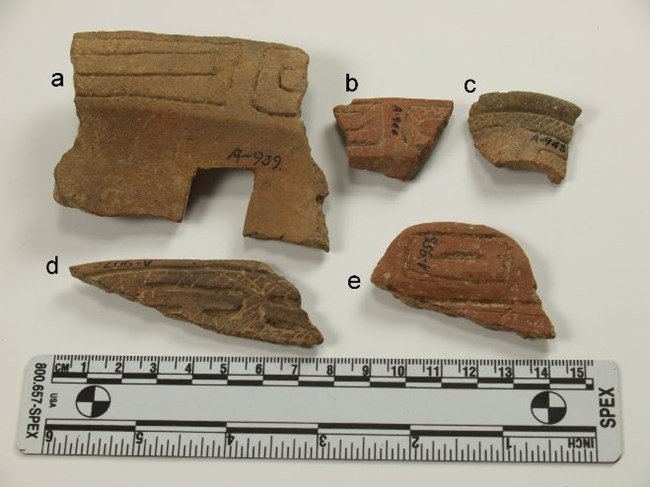
(NPS Photo)
All of the griddle samples that were tested were members of Group 2, as were both of the ZIC wares and all but one sherd of red-on-rim or red-in-zone painted wares of the Coral Bay—Longford phase (ca. A.D. 400-600).
Next, the results were compared to a database of Caribbean ceramics (also kept at MURR). It was discovered that several sherds from sites in the Dominican Republic and Puerto Rico were likely made on St. Croix. In other words, they were members of Group 2.
Group 1 was represented by three sherds from Salt River and two sherds from the St. Georges site, one being a light colored chalky ware, and one a refined WOR ware. These results were also compared to MURR’s pan-Caribbean prehistoric pottery database. Because of a strong overlap between these Group 1 samples and a strong grouping of sherds listed in the database as having been made on Puerto Rico, it is likely that these Group 1 ceramics from St. Croix were also made on Puerto Rico.
The remaining sherds and clays could not be assigned to any single group, and there were no links between these samples and those from other islands listed in the MURR database. These samples included a brown and white painted sherd from the Prosperity site, one sample of refined WOR ware (Prosperity site), and an orange filmed sherd with red painting outlined by incisions (Windsor site). It is possible that these sherds could have been made from clays obtained from an unknown off-island source, or they could have been made from St. Croix clays that were not sampled.
Part II. Stone Study
The second part focused on the transportation of polished stone celts or axes and small stone ornaments carved in the shapes of animals, primarily frogs and other reptilian or amphibian-like creatures (Figures 5 through 7). These stone artifacts are the most cited evidence for the existence of ancient long distance networks of interisland exchange across the Caribbean. Several styles of these ornaments have been identified from sites across the region that correspond to studies conducted of similar ornaments and raw materials (Boomert 1987; Cody 1990, 1991; Crock and Bartone 1998; Kelker 1985; Knippenberg 2006; McGinnis 1997; Narganes Storde 1995a, 1995b; Rodriguez 1991; Watters and Scaglion 1984). It is not known if raw, untouched stone or finished products were moved. Highly polished "greenstone" axes and celts, with no evidence of wear resulting from being used as tools, have been recovered from several sites across St. Croix, including Aklis, Judith’s Fancy, Prosperity, Richmond, St. Georges, and Salt River. They have also been recovered from numerous other sites from across the Caribbean. Their polished, unblemished surface is possible evidence for their use as valued, important symbols of power and knowledge. Many of these polished axes and celts were made of a variety of "greenstone" materials that resemble light green jadeites (Harlow et al. 2006).
The frog and other amphibian-style (or "batrachian") ornaments were hung in one of two styles, the muiraquita-style (Amazonian) with suspension holes drilled into the sides and back so they could not be seen from the front, and a simpler style where holes drilled from front to back. Other simpler styles of pendants were also tested, made out of materials resembling turquoise, malachite, and amazonite. A total of 39 artifacts from the Folmer Andersen Collection were sent to the Department of Earth and Planetary Sciences at the American Museum of Natural History (New York City) for identification using scanning electron microscope (SEM), with a back-scattered electron detector (BSE) and a PGT-Imix energy-dispersive X-ray spectrometric analyzer (EDS).
Analysis using an electron microprobe determined the concentrations of the primary elements comprising the minerals. The artifacts tested included nine stone celts and 16 carved stone ornaments, including six frogs or "batrachian" styles and ten other types (caterpillar-style and simple beads) (Figure 8). Two "greenstone" flakes and 12 pieces of raw "greenstone" and "turquoise" were also submitted for testing. It was discovered that many of the groundstone axes and celts were most likely made of jadeites only available from one place, the Motagua River Valley, Guatemala. This location was the source for many of the jades used by the Maya; the Motagua Valley was occupied from the Late Preclassic (ca. 400 BCE – 200 CE) through the Late Postclassic periods (ca. 900-1500 CE), with several sites served as production centers or workshops.
The results of this analysis are similar to those from recent studies conducted on jadeite axes excavated from the island of Antigua, where the source was also identified as Motagua (Harlow et al. 2006; Murphy et al. 2000). These studies prove that the ancient Saladoid peoples who migrated and settled onto the Caribbean islands beginning nearly 2,000 years ago had some kind of contact with societies in regions outside those traditionally associated with the Saladoid cultural region (i.e. the Caribbean and the Lower Orinoco River Valley). The greenstone ornaments, on the other hand, were carved out of a variety of materials commonly referred to as social jades, namely nephrite, serpentine, chrysoprase, albitite, and quartzites like fuchsite. Many of these social jades could have been obtained from neighboring islands. As of now, though, sources of these artifacts are unknown. The "turquoise" objects were identified as malachite and pseudomalachite, with some turquoise. Malachite and turquoise form in dry climates, weathering from copper ores and often associated with limestone deposits (George Harlow, personal communication 2008). Copper deposits related to arc volcanism are located on Puerto Rico, the Virgin Islands (St. John), and the Lesser Antilles, and Cox and Briggs (1973:3) noted that all copper deposits on Puerto Rico "contain some malachite or azurite."
Summary
Evidence presented in this study of geochemical sourcing of artifacts has illustrated the complex interactions and potential relations that can exist in supposed simple, egalitarian societies. Stylistic changes in ceramics on St. Croix and throughout the Virgin Islands indicate some degree of interaction with communities in eastern Puerto Rico and eastern Hispaniola. These relations were confirmed by the chemical evidence from the pottery study - early wares were imported from Puerto Rico, and that Crucian wares were transported to Puerto Rico and Hispaniola (Dominican Republic), indicating that some kind of long distance exchange relationship existed between these communities nearly 1,500 year ago.
The research has also shown that production of nearly all the tested pottery was confined to only a few places located near particular kinds of clays. The pottery, or clay, was then transported to other villages across the island. Based on the results of the NAA analysis and the comparisons to other geochemical studies on neighboring islands, it appears that pottery production was mostly local and conducted on island. There were also no differences between the kinds of clays used and ceramic styles: WOR and ZIC wares, refined and utilitarian wares, hollow forms and griddles were all made from basically the same kinds of clays.
Regarding the two kinds of stone artifacts studied here, each type was made of two different stones that resembled each other in color, true jadeitite (celts) and social jades like nephrite, serpentine, albite, and chrysoprase (ornaments).
In sum, many Saladoid-period archeological sites, from both St. Croix and other islands across the northern Lesser Antilles and Greater Antilles, have produced evidence that their residents participated in regional interaction spheres. This evidence is in the form of beads and ornaments made of stone and shell, ground stone celts made from jadeites obtained from far away places, and well-made pottery. Some of these communities (possibly known as Houses) likely functioned as specialized, part-time production centers. In some cases, these production villages did not need to be located near the sources of their materials, indicating that raw materials were moved from a point of origin to the place of production, and then possibly on to a final destination.
This research has aided the National Park Service staff at CHRI, SARI, and SEAC to better interpret the prehistoric lifeways of the ancient peoples of St. Croix and the Virgin Islands to the parks’ visitors. It has allowed for better management and protection of the cultural landscape and ancient heritage for the people of the Virgin Islands. This study has also demonstrated the importance and usefulness of museum collections for interpretation, education, and scientific research into the ancient past.
Acknowledgments
Special thanks go to former SEAC directors Bennie Keel and John Ehrenhard, Acting SEAC Director George Smith, and Guy Prentice, Manager of the Regionwide Archeological Survey Program, for their support and help throughout this study. The neutron activation analysis was conducted by Jeff Ferguson and Michael Glascock of the Archaeometry Laboratory Missouri University Research Reactor, and the electron microprobe and scanning electron microscope was conducted by George Harlow of the Department of Earth and Planetary Sciences, Amercian Museum of Natural History. A special thank you goes to Birgit Faber Morse. Finally, thanks go to Superintendent Joel Tutein and Chief of Resource Management Zandy Hillis-Starr, Salt River Bay National Historic Site and Ecological Preserve and Christiansted National Historic Site, St. Croix, for all of their support and interest in this study over the last several years. Much of this research was paid for by a National Park Service Albright Wirth Grant (2005), and by Christiansted National Historic Site (National Park Service).
References
Boomert, A.
1987 Gifts of the Amazons: ‘Greenstone’ Pendants and Beads as Items of Ceremonial Exchange in Amazonia and the Caribbean. Antropológica 67: 33-54.
Carini, S.P.
1991 Compositional Analysis of West Indian Saladoid Ceramics and their Relevance to Puerto Rican Prehistory. Unpublished Ph.D. dissertation, University of Connecticut, Storrs.
Cody, A.
1990 Prehistoric patterns of exchange in the Lesser Antilles: Materials, models, and preliminary observations. Unpublished Master of Arts thesis, San Diego State University.
1991 Distribution of Stone Artifacts through the Lesser Antilles: Their Implications for Prehistoric Interaction and Exchange. In Proceedings of the Fourteenth Congress of the International Association for Caribbean Archaeology, edited by A. Cummins and P. King, pp. 589-604. Barbados Museum and Historical Society, St. Ann's Garrison, St. Michael, Barbados.
Costin, C. L.
2007 Thinking about Production: Phenomenological Classification and Lexical Semantics. In Rethinking Craft Specialization in Complex Societies: Archaeological Analyses of the Social Meaning of Production, edited by Zachary X. Hruby and Rowan K. Flad, pp. 143-162. Archeological Papers of the American Anthropological Association, Number 17, Hanover.
Costin, C. L., and M. B. Hagstrum
1995 Standardization, Labor Investment, Skill, and the Organization of Ceramic Production in Late Prehispanic Highland Peru. American Antiquity 60(4): 619-639.
Cox, D. P., and R. P. Briggs
1973 Metallogenic Map of Puerto Rico. Miscellaneous Geologic Investigations Map I-721. U. S. Geological Survey, Washington, D.C.
Crock, J. G., and R. N. Bartone
1998 Archaeology of Trants, Montserrat. Part 4. Flaked Stone and Stone Bead Industries. Annals of the Carnegie Museum 67(3): 197-224.
Ferguson, J.R. and M.D. Glascock
2006 Instrumental Neutron Activation Analysis Late Saladoid Pottery from St. Croix, U.S. Virgin Islands. Archaeometry Laboratory Missouri University Research Reactor University of Missouri, Columbia.
Hardy, M.
2008 Saladoid Economy and Complexity on the Arawakan Frontier. Unpublished Ph.D. dissertation, Department of Anthropology, Florida State University, Tallahassee.
Harlow, G.E., A.R. Murphy, D.J. Hozjan, C.N. de Mille, and A.A. Levinson
2006 Pre-Columbian Jadeite Axes from Antigua, West Indies: Description and Possible Sources. The Canadian Mineralogist 44(2): 305-321.
Kelker, N. L.
1985 An Historical Tradition in the Art of the Pre-Columbian Southwest Caribbean Lowlands. Unpublished Ph.D. dissertation, University of Texas, Austin.
Knippenberg, S.
2006 Stone Artefact Production and Exchange among the Northern Lesser Antilles. Unpublished Ph.D. dissertation, Department of Caribbean Archaeology, Leiden University, Leiden, Netherlands.
Murphy, A. R., D. J. Hozjan, C. H. deMille, and A. A. Levinson
2000 Pre-Columbian Gems and Ornamental Materials from Antigua, West Indies. Gems and Gemology: 234-245.
McGinnis, S. A. M. 1997 Ideographic Expression in the Precolumbian Caribbean. Unpublished Ph.D. dissertation, University of Texas, Austin.
Narganes Storde, Y. M.
1995a La Lapidaria de La Hueca, Vieques, Puerto Rico. In Proceedings of the Fifteenth Congress of the International Association for Caribbean Archaeology, edited by R. E. Alegría and M. Rodriguez, pp. 141-151. Centro de Estudios Avanzados de Puerto Rico y el Caribe, San Juan, Puerto Rico.
1995b La Lapidaria de Sorce, Vieques, y Tecla, Guayanilla, Puerto Rico. In Proceedings of the Sixteenth Congress of the International Association for Caribbean Archaeology, pp. 17-26. Basse Terre, Guadeloupe.
O'Connor, B. C.
1999 Sourcing for Temper and Clay in Ceramics from Selected Sites on the United States Virgin Islands. In The Proceedings of the Seventeenth Congress of the International Association for Caribbean Archaeology, edited by J. H. Winter, pp. 148-153. Molloy College, NY.
Potter, D.
1996 Chemical Analysis of Clay and Prehistoric Pottery from St. John, U.S. Virgin Islands, Using PIXE and X-Ray Diffraction Analyses. Unpublished Master of Science thesis, Florida State University, Tallahassee.
Rodriguez, M.
1991 Arqueologica de Punta Candelero, Puerto Rico. In Proceedings of the Fourteenth Congress of the International Association for Caribbean Archaeology, edited by A. Cummins and P. King, pp. 605-627. Barbados Museum and Historical Society, St. Ann’s Garrison, St. Michael, Barbados.
Watters, D. R., and R. Scaglion
1994 Beads and Pendants from Trants, Montserrat: Implications for the Prehistoric Lapidary Industry of the Caribbean. Annals of the Carnegie Museum, 63 (3): 215-237.
